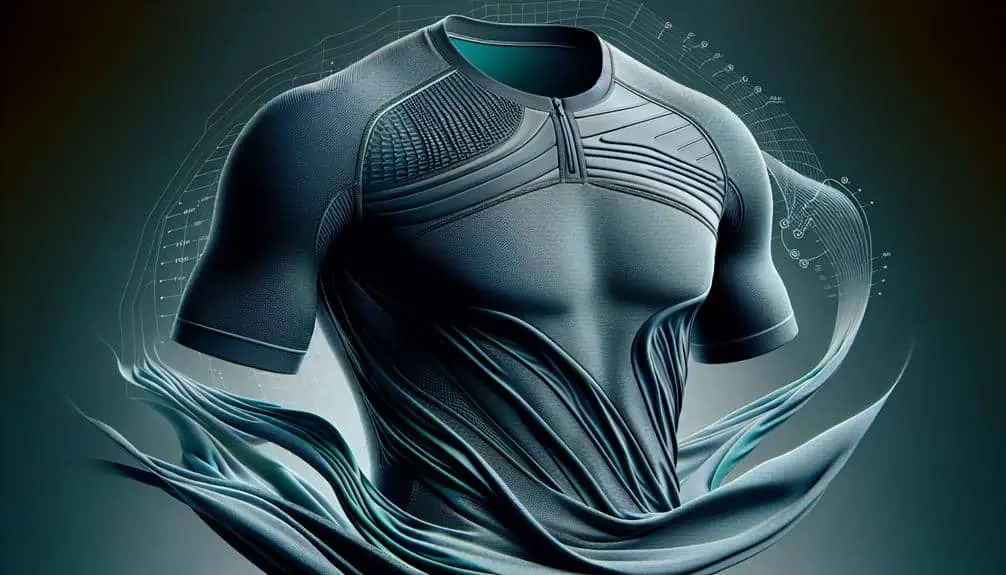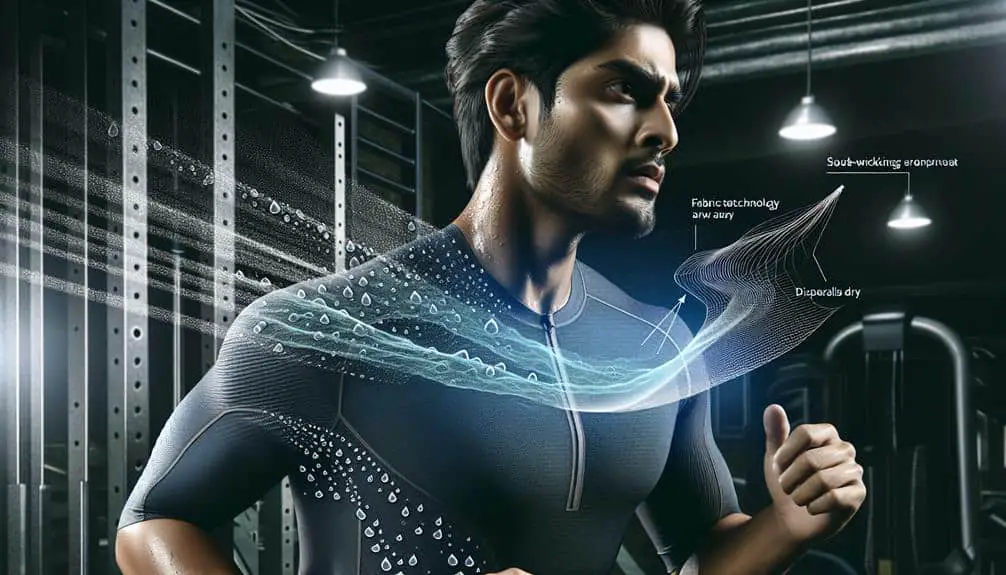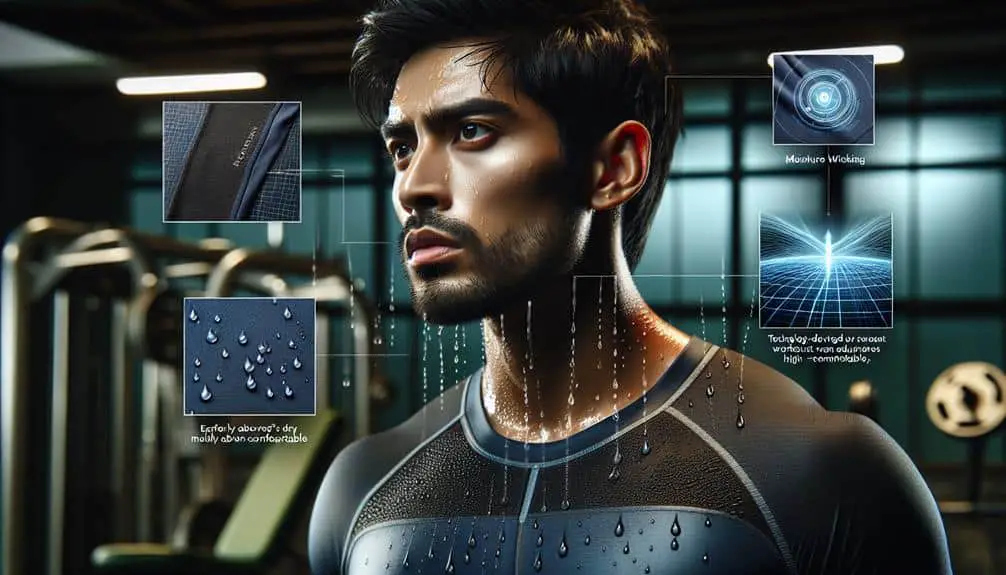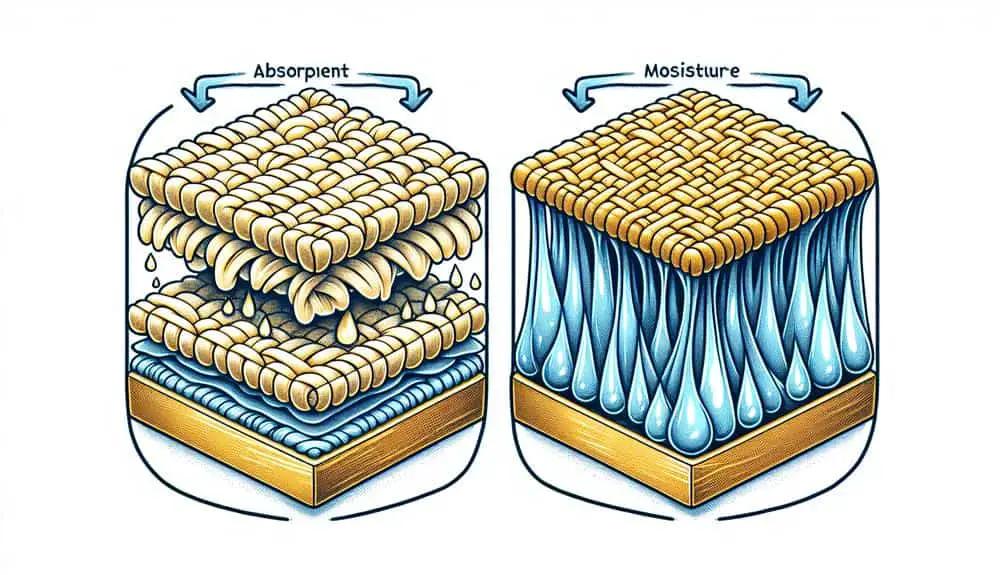For the best moisture-wicking shirts, look for fabrics like polyester, nylon, Merino wool, polypropylene, and bamboo fiber. Polyester offers excellent moisture management and durability. Nylon is strong, tear-resistant, and allows unrestricted movement. Merino wool is natural, odor-resistant, and regulates temperature. Polypropylene efficiently manages sweat and repels water. Bamboo fiber is sustainable, gentle on skin, and prevents odors. These materials provide various benefits to keep you dry and comfortable during physical activities. Understanding the fabric technology in moisture-wicking shirts can enhance your overall comfort and performance.
Key Points
- Polyester: Excellent moisture management and durability in activewear.
- Nylon: Strong, elastic, and moisture-wicking with good shape retention.
- Merino Wool: Natural wicking, odor-resistant, and temperature-regulating properties.
- Polypropylene: Lightweight, moisture-wicking, and resistant to mildew.
- Bamboo Fiber: Sustainable, moisture-wicking, and gentle on the skin.
Polyester
Polyester fabric is commonly used in moisture-wicking shirts due to its excellent moisture management properties. Its durability is unmatched in the world of activewear fabrics, making it a top choice for athletes and fitness enthusiasts. The fabric's ability to withstand repeated washings and high-intensity activities without losing its shape or color gives it a significant advantage over other materials.
In terms of breathability, polyester allows for efficient air circulation, keeping the body cool and dry during intense workouts. This feature is essential for moisture-wicking shirts as it helps prevent the buildup of sweat and heat, enhancing overall comfort and performance. The fabric's quick-drying properties further aid in maintaining a dry and sweat-free environment, reducing the risk of chafing and irritation.
Nylon
Nylon, a synthetic fabric known for its strength and elasticity, plays an essential role in the construction of moisture-wicking shirts. When it comes to durability benefits, nylon stands out due to its resistance to abrasion and tearing, making it an excellent choice for athletic performance. The fabric's ability to maintain its shape and structural integrity even after repetitive use and wash cycles is vital for athletes who require long-lasting apparel that can withstand intense workouts.
In terms of athletic performance, nylon's moisture-wicking properties excel in keeping the wearer dry and comfortable during physical activities. By quickly drawing sweat away from the skin to the outer surface of the fabric where it can evaporate, nylon helps regulate body temperature and prevent the discomfort caused by excessive moisture. Additionally, nylon's lightweight nature and flexibility allow for unrestricted movement, enhancing overall performance during workouts and sports activities. For athletes seeking durable, high-performance moisture-wicking shirts, nylon fabric is a top choice.
Merino Wool
When choosing moisture-wicking shirts, Merino wool emerges as a top choice due to its exceptional natural properties. Merino wool, obtained from Merino sheep, offers numerous benefits for activewear. Its natural wicking properties efficiently draw moisture away from the skin, keeping you dry and comfortable during physical activities. Merino wool is also odor-resistant, making it an excellent option for long-duration wear without the worry of unpleasant smells.
In comparison to synthetic fabrics, Merino wool stands out due to its breathability and temperature-regulating properties. It helps to keep your body at a perfect temperature in varying conditions, ensuring comfort throughout your workout or outdoor adventure. Additionally, Merino wool is biodegradable and renewable, making it an eco-friendly choice for those conscious of sustainability.
To care for your Merino wool moisture-wicking shirts, it's best to hand wash them in cold water with a mild detergent to maintain their quality and prevent shrinkage. Avoid using fabric softeners or bleach and lay the garment flat to dry to sustain its longevity and performance.
Polypropylene
Polypropylene fabric, known for its lightweight and moisture-wicking properties, is a popular choice for activewear enthusiasts seeking efficient sweat management during physical activities. The benefits of polypropylene lie in its ability to quickly draw moisture away from the skin, keeping you dry and comfortable. This fabric is hydrophobic, meaning it repels water, allowing sweat to evaporate easily. Polypropylene is also resistant to mildew, mold, and bacteria growth, making it an ideal option for those with sensitive skin or allergies.
The moisture-wicking properties of polypropylene are unmatched, making it a top choice for high-intensity workouts or outdoor adventures. The fabric dries rapidly, ensuring that you stay dry even during intense physical exertion. Additionally, polypropylene is durable and maintains its shape well, even after multiple washes, making it a long-lasting investment for your activewear collection.
Bamboo Fiber
With its rising popularity in activewear, bamboo fiber offers a sustainable and eco-friendly alternative for moisture-wicking clothing options. Bamboo fiber benefits from being a natural and biodegradable material that possesses excellent moisture-wicking properties ideal for athletic apparel. Here are three key aspects highlighting the advantages of bamboo fiber in sustainable clothing innovation:
- Eco-Friendly Production: Bamboo is a highly sustainable resource due to its rapid growth cycle and minimal need for pesticides or irrigation. This makes bamboo fiber an environmentally friendly choice for those seeking sustainable clothing options.
- Moisture-Wicking Properties: Bamboo fabric is known for its exceptional moisture absorption and ventilation capabilities, keeping you dry and comfortable during physical activities. The structure of bamboo fibers allows for efficient moisture evaporation, preventing the growth of odor-causing bacteria.
- Softness and Comfort: Despite its moisture-wicking abilities, bamboo fabric remains soft and gentle on the skin. The smooth texture of bamboo fiber makes it a popular choice for those with sensitive skin or those looking for a comfortable workout experience.
Frequently Asked Questions
How Do Moisture-Wicking Shirts Compare in Terms of Odor Control Between Different Fabric Technologies?
When comparing fabric technologies for moisture-wicking shirts, you'll find variations in odor control performance. Understanding these distinctions can help you choose the most suitable fabric for your needs, ensuring peak comfort during physical activities.
Can Moisture-Wicking Shirts Made From Bamboo Fiber Be Considered Eco-Friendly and Sustainable?
When considering bamboo fiber sustainability, you'll find it offers numerous benefits. Not only does it excel in moisture-wicking properties, but its eco-friendly nature makes it a top choice for those seeking odor control in garments.
Are There Any Specific Care Instructions or Tips for Maintaining the Moisture-Wicking Properties of Shirts Made From Merino Wool?
To sustain the moisture-wicking properties of merino wool shirts, adhere to these washing guidelines: utilize a gentle cycle with cold water and mild detergent. Drying suggestions include air-drying to prevent shrinking. Proper maintenance guarantees fabric longevity and peak performance.
Do Moisture-Wicking Shirts Made From Polypropylene Have Any Potential Health or Skin Irritation Concerns?
When considering moisture-wicking shirts made from polypropylene, potential concerns may arise regarding skin reactions. Understanding the fabric's composition, breathability, and your skin's sensitivity is essential for minimizing any irritation and ensuring comfort during wear.
How Do the Costs of Moisture-Wicking Shirts Made From Different Fabric Technologies Compare to Each Other?
When comparing the costs of moisture-wicking shirts based on different fabric technologies, consider factors like fabric durability. Evaluating durability helps determine the long-term value of these shirts and can guide you in making an informed purchasing decision.




